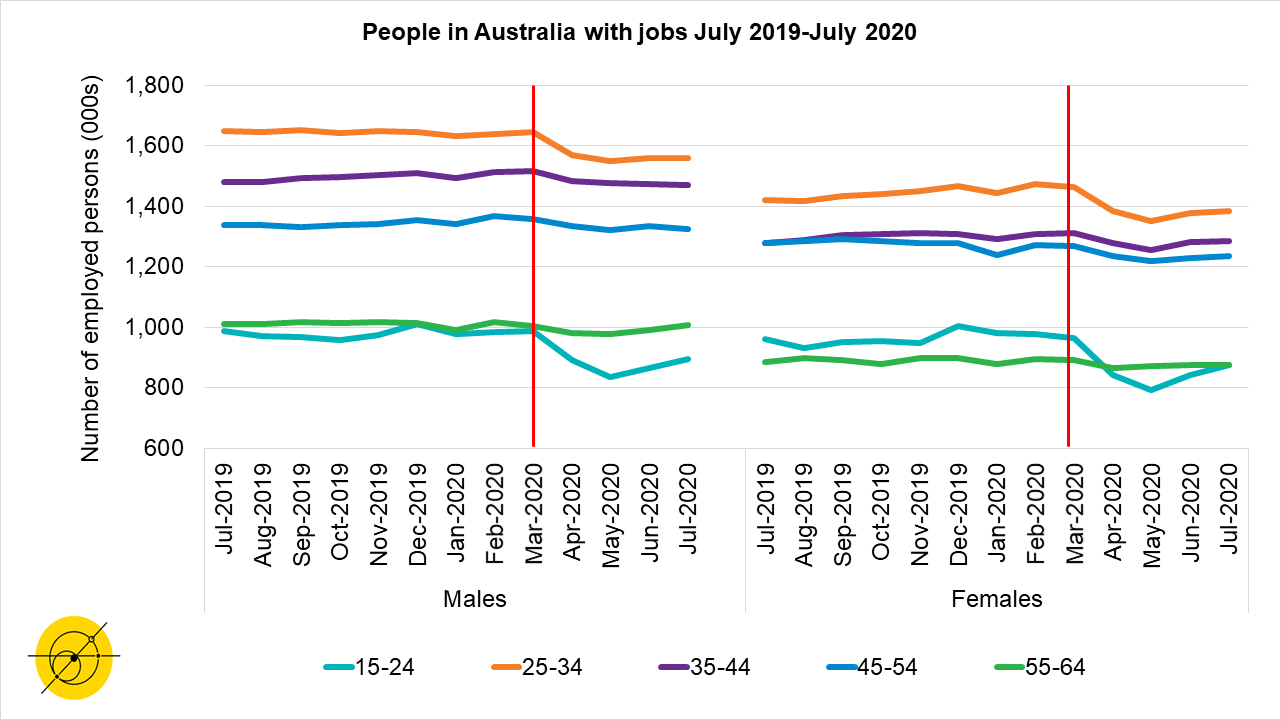Under the banner of the fourth Industrial Revolution, there has long been lots of talk and planning about the types of jobs we’d be doing in the future as new technology influences the type of work we do.
The impact of a global pandemic has accelerated this conversation. It has placed demands on us to work from home if possible, and changed how we interact on an everyday basis. But the impacts on our working lives have been felt differently across Australia, depending on:
- where you live,
- your profession, and
- your age.
What can we learn from employment data?
One of the most important factors that will affect the future of work is whether you’re working right now. We’ve charted the last 12 months of employment data to July 2020, showing people with jobs, and people looking for work.

People in Australia with jobs July 2019-July 2020. Data Source: ABS Labour Force data
In the year to July 2020, three things stand out.
1. There were job losses seen in every age group
2. Job losses were the most marked for people in the youngest age groups
3. Women were employed at lower levels than men throughout
People only have to be employed for one hour a week to be counted in these data; as a result, these figures don’t measure underemployment – those people wanting more hours of work than they currently have.

People in Australia with jobs July 2019-July 2020. Data Source: ABS Labour Force data
Unemployment data are even more stark. Young people were already over-represented in unemployment data compared to other age groups, but COVID-19 has seen many thousands more people join the search for work.
Notable is the stark increase in unemployment among people in their late 20s and early 30s, also in the early stages of their career. Among women aged 15-24, for example, unemployment has increased 50% over the past year. These young people risk long-term negative impacts for their working lives if they remain out of work for too long, or are not engaged in work that provides a meaningful platform for their career.
How did the 2020-21 budget respond?
The Australian Government budget for 2020-21 (delivered in October due to COVID-19) recognises the impact of the pandemic on employment including a JobMaker Plan that includes:
- JobMaker Hiring Credit lasting 12 months for people up to age 35 who’ve been out of the workforce for at least three months, who are employed in new jobs in addition to existing staffing by businesses not using JobKeeper.
- Boosting Apprenticeship Wage Subsidy up to 50%. The top occupations supported by this subsidy are: bricklayers, carpenters and joiners, electricians, plumbers, auto electricians and mechanics and hairdressers.
- A range of training supports from short courses to university places.
- Lower taxes through personal income tax rebates and asset write off and loss carry-back for business tax returns. These responses are described as essential for driving demand for goods and services from consumers and improving cash flow for businesses enabling greater employment.
- Investment in delivery of infrastructure projects.
A lot has been written about how these initiatives do little to address the negative impact on women of the pandemic. Women in service industry jobs have been particularly hard hit and the initiatives above are not directed at these types of jobs but rather focus on construction and trades, occupations we know are heavy male clusters for employment. Moreover, many of the service jobs have been supported by JobKeeper – so even if the economy improves, they are ineligible for JobMaker.
There are also concerns about confining JobMaker to younger workers. While young people have been hard hit in terms of job loss and rising unemployment, among women aged 45-54 there were over 43,000 fewer women in jobs in June 2020 compared to a year earlier and over 26,000 more mid-age women classified as unemployed. For women who may have already had career progression impacted by having children, losing your job at this age can be a segue to permanent and ongoing unemployment.
